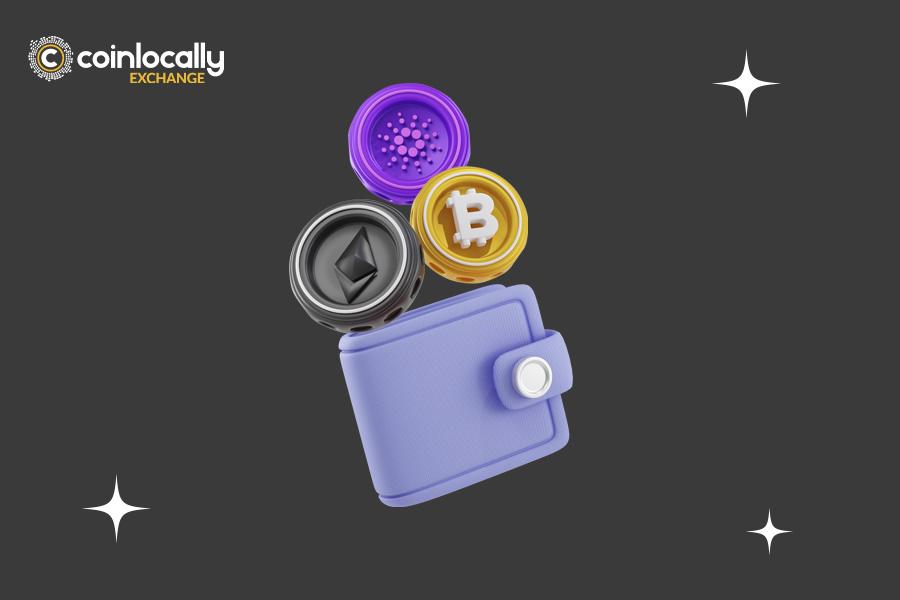Cryptocurrency scams have increased with the rise in popularity of cryptocurrency as an investment option, particularly when markets surge and the ensuing FOMO causes even the savviest investors to occasionally let their guard down. Scammers and fraudsters utilize a variety of strategies to trick investors and take their money.
Quick Getaway: Looking for a safe platform that offers the most secure cryptocurrency trading platform? Signup with Coinlocally and enjoy the best Cryptocurrency trading strategies.
Table of Contents
• The FTC Study about Cryptocurrency Scammers
• What did the investigation uncover?
• Crypto Scams to Avoid at All Costs
- Social Engineering Scams
- Phishing Scams
- Pump and dump schemes
- Scam apps
- Fake celebrity endorsements
- Giveaway scams
- Blackmail and extortion scams
- Cloud mining scams
• How to Recognize Cryptocurrency Scams
- Guaranteed returns
- A poor or non-existent whitepaper
- Excessive marketing
- Unnamed team members
- Free Money
The FTC Study about Cryptocurrency Scammers
According to an FTC study from 2022, scammers frequently use cryptocurrencies to steal people’s money. Crypto transactions are a prime target for scammers because there is no centralized authority to identify questionable transactions and they cannot be undone.
With a median loss of $2,600, approximately 46,000 victims have reported losing over $1 billion in cryptocurrency scams since 2021. Since many victims prefer to maintain their anonymity, the actual figure is probably far higher.
What did the investigation uncover?
• The cryptocurrency that is most commonly used to pay scammers is Bitcoin, which is followed by Tether (USDT) and Ether (ETH).
• Social media advertisements, posts, or messages were the source of 50% of reported crypto fraud losses.
• Surprisingly, Telegram, Facebook, WhatsApp, and Instagram are the leading platforms for losses.
• The most prevalent form of cryptocurrency fraud loss, accounting for $575 million since 2021, is investment fraud.
• Second place goes to romance scams, which cost $185 million, with a $10,000 median loss per victim.
Crypto Scams to Avoid at All Costs
It is crucial for you to be aware of these risks and take precautions for safeguarding your funds from crypto fraud. Here are some of the most significant cryptocurrency fraud risks for 2023 and beyond, along with an explanation of how they operate.
Please be aware that some of these dangers overlap with one another; for instance, social engineering scams include phishing attacks and other tactics.
1. Social Engineering Scams
Social engineering is the method used to get unauthorized access to private data, cryptocurrency wallets, or accounts, as well as to trick victims into installing malware on their computers and networks and therefore cause more damage.
Social engineering frauds utilize psychological duping to get their victims to hand over their cryptocurrencies. Always be skeptical of any unsolicited offers or demands, and confirm the identity of the person or entity you are working with, to avoid falling victim to this kind of con.
These methods cover a variety of strategies, including:
• Baiting is when someone’s greed is used, as with free media downloads.
• Pretexting is when an assailant poses as a reliable person, like a police officer or a doctor.
• Tailgating is when a scammer gains physical access to a business by convincing a worker to let him or her in.
• Quid pro quo attacks, in which a reward is guaranteed in exchange for providing sensitive information, like a study, are a sort of tailgating, where a con artist gains physical entry to a business by convincing an employee to permit him or her.
2. Phishing Scams
Phishing scams have one major objective: to trick cryptocurrency holders into giving up sensitive personal information, such as their login information for crypto exchanges or a private key or recovery seed, and then to exploit that information to steal their money. Fraudsters accomplish this by posting links to phony websites or information-gathering apps in emails or social media communications. Avoid clicking on any indirect links and always go to the website’s main page.
The use of phishing scams to target the unaware clients of businesses like Coinbase, OpenSea, and Ledger through emails, social media posts, and SMS texts (Smishing), after first hacking the databases containing personal user information of those organizations, has been very successful in the past.
3. Pump and dump schemes
Through an email blast or social media sites like Twitter, Facebook, or Telegram, con artists will hype up a certain coin or token. Tradesmen hurry to purchase the coins because they don’t want to miss out, which raises the cost. After successfully driving up the price, the con artists liquidate their shares, which leads to a crash as the asset’s value rapidly drops. This can occur in a matter of minutes.
4. Scam apps
Scammers frequently use bogus apps that can be downloaded from Google Play and the Apple App Store to deceive cryptocurrency investors. These bogus apps are swiftly identified and taken down, but that doesn’t mean they aren’t having an effect on many bottom lines. Numerous people have downloaded phony cryptocurrency applications.
5. Fake celebrity endorsements
To attract potential targets, cryptocurrency scammers occasionally adopt celebrity, corporate, or influencer personas or make claims about endorsements from these individuals. This occasionally entails marketing fake cryptocurrency to unsophisticated investors. Sophisticated websites and pamphlets that purport to have celebrity endorsements from well-known figures like Elon Musk are sometimes used in these scams.
6. Giveaway scams
In what is known as a giveaway scam, the con artists here claim to equal or multiply the cryptocurrency handed to them. Clever messaging from what frequently appears to be a legitimate social media account can engender a sense of legitimacy and urgency. People may send money rapidly in the hopes of receiving an immediate return because this opportunity is supposedly a “once in a lifetime” chance.
7. Blackmail and extortion scams
Blackmail is yet another technique scammers employ. They send emails threatening to reveal the user’s history of visiting adult websites unless the recipient shares their private keys or transfers money to the scammer.
8. Cloud mining scams
Cloud mining refers to businesses that let you rent mining equipment they run in return for a set charge and a percentage of the profits you will allegedly make. Theoretically, this enables anyone to mine remotely without investing in costly mining hardware. In contrast, a lot of cloud mining businesses are frauds or, at best, unproductive, causing you to lose money or make less than expected.
How to Recognize Cryptocurrency Scams
So, how can one recognize a cryptocurrency scam? The following are some red flags to look out for
1. Guaranteed returns
Because investments can go up as well as down, no financial investment can guarantee future returns. Any cryptocurrency offering that makes a guarantee that you will profit is a warning sign.
2. A poor or non-existent whitepaper
An initial coin offering’s whitepaper is one of the most important components, so every cryptocurrency should have one. A cryptocurrency whitepaper should include information on the design and functionality of the coin. If the whitepaper is illogical or, worse yet, doesn’t exist, proceed with caution.
3. Excessive marketing
All companies promote themselves. But investing heavily in marketing, such as internet advertising, paid influencers, offline promotion, and so on, is one way that cryptocurrency scammers draw people in. This aims to raise money quickly and reach as many people as possible in the shortest amount of time. If you believe a crypto offering’s marketing is pushy or makes extravagant claims without any support, you might want to stop and do more research.
4. Unnamed team members
It should be possible to identify the primary individuals behind the majority of investment businesses. This typically entails accessible bios of the investment’s managers as well as a vibrant social media presence. Be wary if you can’t identify the owner of a coin.
5. Free Money
Any investment opportunity that claims to offer free money, whether in fiat currency or cryptocurrency, is likely to be a scam.
How to protect yourself from crypto scams
Cryptocurrency scams are common and usually very well executed. The following actions involve cryptocurrency scam prevention measures and can be taken as tips for how to invest in cryptocurrency:
1. Protect your wallet
Due diligence in cryptocurrency investing, you need a wallet with private keys, so protect it. It could be the signs of red flags of fraudulent cryptocurrency schemes if a company requests your keys so you can take advantage of an investment opportunity. Secure the keys to your wallet.
2. Pay careful attention to your wallet app.
Send a small amount the first time you send money to check the legitimacy of the app. Stop updating your wallet app and remove the software if you notice any odd behavior.
3. Buy only things you are familiar with and understand.
It is important to take a break and conduct additional studies if you are unsure of how a specific cryptocurrency operates before deciding whether or not to invest.
4. Take your time
Scammers usually use high-pressure techniques to persuade you to spend your money quickly, such as by making bonuses or discounts if you do so immediately. For avoiding Ponzi schemes in the crypto space, make sure to take your time and conduct independent research before making any purchases.
5. Avoid cold calls
It’s certainly a fraud if someone reaches you unexpectedly to sell you a cryptocurrency investment opportunity. Never give anyone who contacts you in this way your personal information or money.
6. Use Only Official and the Best Crypto Trading Platforms and Exchanges to Download apps
Downloading apps from the Apple App Store or Google Play Store is safer than doing so from other sources, despite the possibility of fake apps appearing there.
Coinlocally is a secure and reliable cryptocurrency trading platform that offers advanced security features, a user-friendly interface, and competitive trading fees. Unlike other platforms, Coinlocally ensures the safety of your funds through its secure cold storage wallet and two-factor authentication system, thereby protecting you from potential cryptocurrency scams.
7. Do research
The most well-known cryptocurrencies are legitimate. For identifying legitimate cryptocurrency projects, do some research on a particular cryptocurrency if you’ve never heard of it. Find out who is in charge of it, how it works, and whether there is a whitepaper you can read. You should also look for authentic reviews and endorsements. To check for scams, find an accurate and reliable list of bogus cryptocurrencies.
8. Avoid too-good-to-be-true offers.
Companies that guarantee returns or promise to make you wealthy overnight are probably scams. If something seems too good to be true, move on with caution.
Finally, never invest money that you can’t afford to lose in an opportunity. Understanding the risks is crucial because cryptocurrency is speculative and volatile even if you aren’t being scammed.
Conclusion
In order to protect your investments from cryptocurrency scams, it is essential to be aware of the red flags of fraudulent schemes and take measures to safeguard your funds.
This guide has covered various types of scams, including social engineering scams, phishing scams, pump and dump schemes, fake celebrity endorsements, giveaway scams, blackmail and extortion scams, and cloud mining scams.
By following the tips and precautions outlined in this guide, you can recognize and avoid cryptocurrency scams and make safe investments.
• Always do your due diligence, research the legitimacy of the investment, and never invest more than you can afford to lose.
• Remember to protect your wallet and pay attention to your wallet app. By being vigilant and cautious, you can minimize the risk of falling prey to cryptocurrency scams and protect your hard-earned funds.
FAQs
• What should I do if I think I have fallen victim to a cryptocurrency scam?
If you think you have fallen victim to a cryptocurrency scam, you should report it to the relevant authorities immediately. You should also contact your bank or financial institution and report the fraud. If you have lost money, you may also want to consider contacting a lawyer or seeking legal advice.
• What is a whitepaper in the context of cryptocurrency?
A whitepaper is a document that outlines the design, functionality, and technical details of a cryptocurrency project. It is an important component of an initial coin offering (ICO) and provides investors with a detailed understanding of the project and its potential risks and rewards.
• What are some red flags to look out for when considering a cryptocurrency investment?
Some red flags to look out for when considering a cryptocurrency investment include guaranteed returns, a poor or non-existent whitepaper, excessive marketing, unnamed team members, and offers of free money. It is important to conduct independent research and due diligence before making any investments.





